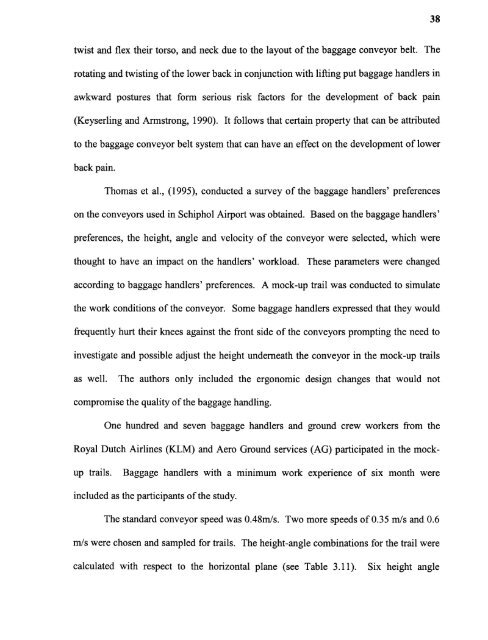An ergonomic assessment of the airline baggage handler
An ergonomic assessment of the airline baggage handler
An ergonomic assessment of the airline baggage handler
Create successful ePaper yourself
Turn your PDF publications into a flip-book with our unique Google optimized e-Paper software.
38twist and flex <strong>the</strong>ir torso, and neck due to <strong>the</strong> layout <strong>of</strong> <strong>the</strong> <strong>baggage</strong> conveyor belt. Therotating and twisting <strong>of</strong> <strong>the</strong> lower back in conjunction with lifting put <strong>baggage</strong> <strong>handler</strong>s inawkward postures that form serious risk factors for <strong>the</strong> development <strong>of</strong> back pain(Keyserling and Armstrong, 1990). It follows that certain property that can be attributedto <strong>the</strong> <strong>baggage</strong> conveyor belt system that can have an effect on <strong>the</strong> development <strong>of</strong> lowerback pain.Thomas et al., (1995), conducted a survey <strong>of</strong> <strong>the</strong> <strong>baggage</strong> <strong>handler</strong>s' preferenceson <strong>the</strong> conveyors used in Schiphol Airport was obtained. Based on <strong>the</strong> <strong>baggage</strong> <strong>handler</strong>s'preferences, <strong>the</strong> height, angle and velocity <strong>of</strong> <strong>the</strong> conveyor were selected, which werethought to have an impact on <strong>the</strong> <strong>handler</strong>s' workload. These parameters were changedaccording to <strong>baggage</strong> <strong>handler</strong>s' preferences. A mock-up trail was conducted to simulate<strong>the</strong> work conditions <strong>of</strong> <strong>the</strong> conveyor. Some <strong>baggage</strong> <strong>handler</strong>s expressed that <strong>the</strong>y wouldfrequently hurt <strong>the</strong>ir knees against <strong>the</strong> front side <strong>of</strong> <strong>the</strong> conveyors prompting <strong>the</strong> need toinvestigate and possible adjust <strong>the</strong> height underneath <strong>the</strong> conveyor in <strong>the</strong> mock-up trailsas well. The authors only included <strong>the</strong> <strong>ergonomic</strong> design changes that would notcompromise <strong>the</strong> quality <strong>of</strong> <strong>the</strong> <strong>baggage</strong> handling.One hundred and seven <strong>baggage</strong> <strong>handler</strong>s and ground crew workers from <strong>the</strong>Royal Dutch Airlines (KLM) and Aero Ground services (AG) participated in <strong>the</strong> mockuptrails. Baggage <strong>handler</strong>s with a minimum work experience <strong>of</strong> six month wereincluded as <strong>the</strong> participants <strong>of</strong> <strong>the</strong> study.The standard conveyor speed was 0.48m1s. Two more speeds <strong>of</strong> 0.35 m-s and 0.6m/s were chosen and sampled for trails. The height-angle combinations for <strong>the</strong> trail werecalculated with respect to <strong>the</strong> horizontal plane (see Table 3.11). Six height angle
















